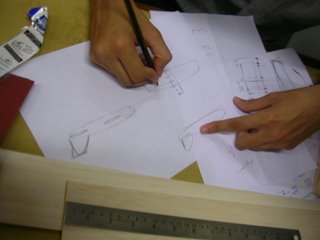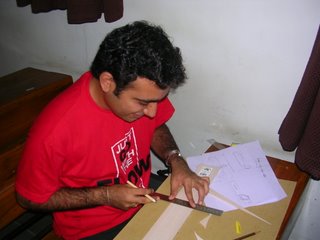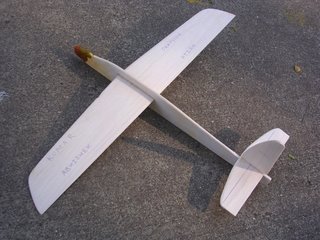My indulgence of aeromodelling also has the same background. I have always wanted to fly, either a small plane or fly in a big one. I had been making static aero models and small flying gliders to see that I can also fly (my miniature planes). But they were kinda work of novice. No formula no parameter checking. It was all based on trial and error basis. I would make a glider, test fly it and see how it acts and then make modifications accordingly to make it stable in air. I knew different concepts of making the glider stay in air, but how they worked was little know.
We had an aeromodelling workshop on 4th Nov, at IIT. I participated in it and was thrilled by the process of making a balsa wood glider, calculating equations for different parts of the plane.
Following is a photo synopsis of what I did in the workshop.
It all started with two strips of balsa wood and other apparatus. Balsa is a special kind of tree with large vaccum tubes running through the lenght making it porous. At the same time it's stiff too. And hence it's famous among aeromodellers as an idle material to make a glider. Very light, dense and stiff material.
 We got the equations and different jargons.
We got the equations and different jargons.Wing, fin, rudder, ailerons, horizontal tail, wing span, wing loading, drag, thrust blah blah.
Loaded the equations with actual number of our model and got the dimensions of each part of the model.
We drew the blue print on paper. We had quite a big discussion on the kind of glider we want to make. The one that flies more, takes longer distance or an unconventional shaped which glides to some distance.
We concluded that simple is the best. And then the cutting shutting and sanding of balsa started.



And that's the final product. It was gliding great in calm winds.
9 comments:
that looks cool...
when you get time out of your assignment and things, make something cooler, which can fly and may be remote controlled :)
This one flies yaar.
where can I get balsa wood in pune. It would be really helpful for me.
@anonymous
actually I'm new to pune so can't say. However there is an aeromodelling club run in pune at hadapsar. they'll be of help in this case. alternatively you can visit http://www.indiarc.com/ for more information about products for this hobby.
Hello Kumar!
Great blog...
I am interested in aeromodelling...
I have been always fascinated towards creating and flying small airplanes...
Is there any club in Pune, where I can learn the art of creating and flying planes...
-Abhijit Dake (Pune).
Hi Abhijit,
There is Pune aeromodelling club which gathers at Hadapsar for flying practice.
I have also given a link to their website and you can get ample amount of information about aeromodelling there.
visit www.indiarc.com
Aeromodelling is a hobby which involves a variety of things. The main concept is to build your own model air crafts and race them or simply play with them on your own. Now, these days the sport/hobby of aeromodelling is slightly better than it used to be. The kind of things that you can make these days is ridiculous. You can literally create your very own model jet if you want to.
Regards.
Andy.
This is exactly what I was looking for.Great info, learned something new!
Aeromodelling is the art of designing, building and flying miniaturized aircrafts. While Aeromodelling has reached a certain degree of complexity, one can build a model plane from any material which may include Paper, Balsa, Composites so on and so forth.
Post a Comment